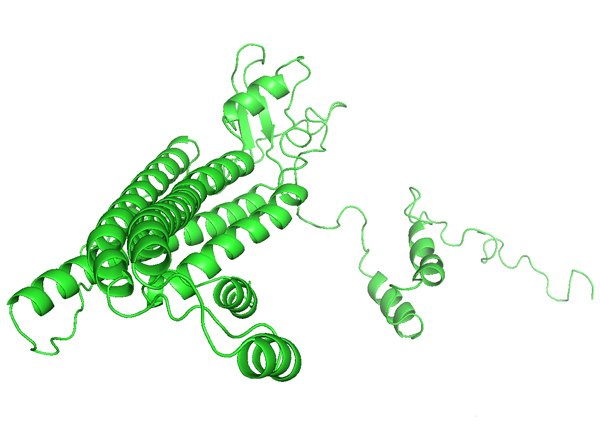Bioinformatics Database
GJA1: Gap junction protein alpha 1

Cellular Process
Cap stage of tooth development
Gene Name
GJA1: Gap junction protein alpha 1
Gene ID
2697
Gene Sequence
General Description
This gene is a member of the connexin gene family. The encoded protein is a component of gap junctions, which are composed of arrays of intercellular channels that provide a route for the diffusion of low molecular weight materials from cell to cell. The encoded protein is the major protein of gap junctions in the heart that are thought to have a crucial role in the synchronized contraction of the heart and in embryonic development.
Alternative titles; symbols
GAP JUNCTION PROTEIN, 43-KD CONNEXIN 43; CX43 HEART CONNEXIN
Chromosome
Chromosome 6
Cytogenetic location
6q22.31
Encoded Protein
Gap junction alpha-1 protein
Function of the protein in oral and tooth development
Gap junction channels in mammalian organs can be built up of at least 13 different connexin proteins, most of which are expressed in only few cell types, although many cells express more than one connexin protein" (Willecke et al., 1999).
Oculo-dento-digital dysplasia (ODDD) is a rare autosomal dominant congenital disorder mainly affecting the development of the face, eyes, skeletal system, heart and dentition. ODDD has been identified in GJA1 (Kelly et al., 2006).
Dental and Oral Diseases
Oculodentodigital dysplasia (ODDD)
(OMIM ID: 164200)
Oculodentodigital dysplasia is an autosomal dominant disorder with high penetrance, intra- and interfamilial phenotypic variability. The syndrome presents with craniofacial (ocular, nasal, and dental) and limb dysmorphisms, spastic paraplegia, and neurodegeneration. Syndactyly type III and conductive deafness occur in some cases, and cardiac abnormalities are infrequent (Paznekas et al. 2003).
Craniometaphyseal dysplasia (CMDR)
(OMIM ID: 218400)
Craniometaphyseal dysplasia is an osteochondrodysplasia characterized by hyperostosis and sclerosis of the craniofacial bones associated with abnormal modeling of the metaphyses. Sclerosis of the skull may lead to asymmetry of the mandible, as well as to cranial nerve compression, that may finally result in hearing loss and facial palsy (summary by Nurnberg et al., 1997).
Protein Sequence
>NP_000156.1 gap junction alpha-1 protein [Homo sapiens]
MGDWSALGKLLDKVQAYSTAGGKVWLSVLFIFRILLLGTAVESAWGDEQSAFRCNTQQPGCENVCYDKSF
PISHVRFWVLQIIFVSVPTLLYLAHVFYVMRKEEKLNKKEEELKVAQTDGVNVDMHLKQIEIKKFKYGIE
EHGKVKMRGGLLRTYIISILFKSIFEVAFLLIQWYIYGFSLSAVYTCKRDPCPHQVDCFLSRPTEKTIFI
IFMLVVSLVSLALNIIELFYVFFKGVKDRVKGKSDPYHATSGALSPAKDCGSQKYAYFNGCSSPTAPLSP
MSPPGYKLVTGDRNNSSCRNYNKQASEQNWANYSAEQNRMGQAGSTISNSHAQPFDFPDDNQNSKKLAAG
HELQPLAIVDQRPSSRASSRASSRPRPDDLEI
Mutations
Oculodentodigital dysplasia (ODDD):
LEU11PRO
Kelly et al. (2006) demonstrated a heterozygous missense mutation of the GJA1 gene: a T-to-C transition at nucleotide 32, predicted to lead to a nonconservative replacement of leucine 11 (CTT) with a proline residue (CCT) in the cytoplasmic amino terminus of CX43.
2-BP DEL, 679AT
In a young Dutch woman with oculodentodigital dysplasia, Vreeburg et al. (2007) identified a 2-bp deletion (679delAT) in the GJA1 gene, resulting in a frameshift and premature termination of the protein, and absence of a significant portion of the C-terminal domain.
ARG33TER
Richardson et al. (2006) identified homozygosity for a C-to-T transition in the GJA1 gene resulting in an arg33-to-ter (R33X) substitution. The mutation is predicted to truncate GJA1 halfway through the first of 4 transmembrane domains, rendering the protein functionless.
ARG76HIS
Pizzuti et al. (2004) identified a homozygous 227G-A transition in the GJA1 gene, resulting in an arg76-to-his (R76H) substitution. The clinically normal parents were heterozygous carriers of the mutation. Pizzuti et al. (2004) had hypothesized that homozygous hypomorphic mutations in GJA1 can result in a phenotype in an HSS/ODDD spectrum.
12-BP DEL, NT120
In a patient with typical features of oculodentodigital dysplasia (ODDD) and the additional features of optic nerve and retinal dysplasia and ciliary body cysts, Gabriel et al. (2011) identified heterozygosity for an in-frame 12-bp deletion at nucleotide 120 in exon 2 of the GJA1 gene, leading to the elimination of 4 amino acids at positions 41-44.
LEU11PHE
In a patient with typical features of oculodentodigital dysplasia (ODDD) and the additional features of optic nerve and retinal dysplasia, Gabriel et al. (2011) identified a de novo heterozygous 31C-T transition in the GJA1 gene, resulting in a leu11-to-phe (L11F) substitution.
LYS206ARG
Brice et al. (2013) identified heterozygosity for a c.617A-G transition in exon 2 of the GJA1 gene, resulting in a lys206-to-arg (K206R) substitution at a highly conserved residue in a functional domain.
Craniometaphyseal dysplasia (CMDR):
ARG239GLN
Hu et al. (2013) identified homozygosity for a c.716G-A transition in exon 2 of the GJA1 gene, resulting in an arg239-to-gln (R239Q) substitution.
Related Literature
Kelly et al., (2006). A novel GJA 1 mutation in oculo-dento-digital dysplasia with curly hair and hyperkeratosis. European journal of dermatology : EJD, 16(3), 241–245.
Willecke et al., (1999). https://doi.org/10.1002/9780470515587.ch6
Paznekas et al., (2003). https://doi.org/10.1086/346090
Kelly et al., (2006). A novel GJA 1 mutation in oculo-dento-digital dysplasia with curly hair and hyperkeratosis. European journal of dermatology : EJD, 16(3), 241–245.
Vreeburg, et al, (2007). https://doi.org/10.1002/ajmg.a.31558
Richardson et al., (2006). https://doi.org/10.1136/jmg.2005.037655
Pizzuti et al., (2004). https://doi.org/10.1002/humu.9220
Gabriel et al., (2011). https://doi.org/10.1001/archophthalmol.2011.113
Brice et al., (2013). https://doi.org/10.1111/cge.12158
Hu et al., (2013). https://doi.org/10.1371/journal.pone.0073576
Nürnberg et al., (1997). https://doi.org/10.1086/514880